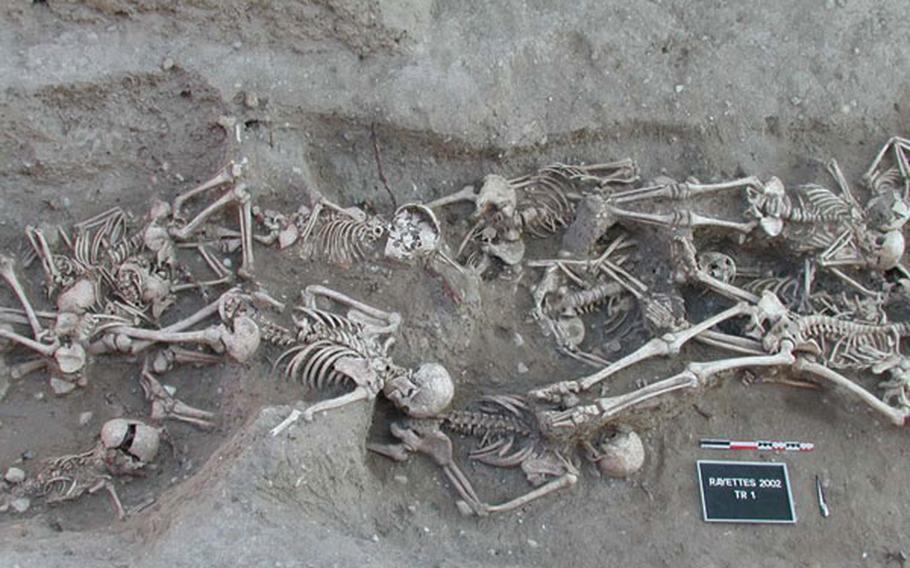
Bubonic plague victims in a mass grave in Martigues, France. (S. Tzortzis/Centers for Disease Control and Prevention)
Agnolo di Tura was a sometime shoemaker and tax collector with a yen for keeping a journal. He was also his family's sole survivor when the Black Death tore through Siena, Italy, in 1348. He buried his wife and five children with his own hands, he wrote in his journal. He was somehow spared.
Many deadly diseases have swept through the human population over the past 10,000 years, claiming some, leaving others. These tragic events left their mark in our DNA. When biologists compare modern genomes to DNA extracted from ancient bones, they can see how genetic variants that enabled people to fight off pathogens have increased in frequency over millennia.
We are the descendants of the survivors, and our genomes show it. But it turns out this genetic history can be a double-edged sword.
In work published in the journal Cell Genomics, researchers found that many of the protective variants that have increased in frequency also raise the risk of autoimmune diseases, in which the immune system turns on the body. It's an intriguing thought: Over the course of human evolution, what saves you might come back to haunt your descendants.
The ability to see these changes and understand their significance is only about a decade or so old. It stems from genome-wide association studies, which look to see whether the genomes of people with a given condition share traits. Such studies have already helped identify genetic risk factors for diseases such as macular degeneration, diabetes and rheumatoid arthritis.
The studies can also look for gene variants that protect against a disease — perhaps the kind of thing that Agnolo di Tura might have possessed during the Black Death.
"What we can do is to combine all this information and we can see all those variants that [have] an effect on disease," said study co-author Gaspard Kerner, a researcher at the Pasteur Institute in Paris.
He and other scientists are now looking at genomes across time as well, so they can start to reconstruct what happened as humans and pathogens crossed paths.
How plagues affect our genes
For their recent study, Kerner and his colleagues examined the genomes of 2,879 Europeans who lived between the Neolithic, when stone tools were first made around 10,000 years ago, and the present day. They found that many of the gene variants that have become more common in that time are linked to immunity.
Most of the changes occurred in the past 4,500 years, suggesting that since the Bronze Age, we've been strongly affected by pathogens.
That tallies with the general idea that living more densely, farming and raising animals might have increased our exposure to infectious diseases, says Mihai Netea, a professor of experimental medicine at Radboud University; he was involved in a study suggesting an earlier date for the beginning of this era of illness.
What's particularly striking, the researchers found, is while variants that make infectious disease riskier have dropped over the millennia, variants linked to autoimmunity have ticked up.
Tauras Vilgalys, a geneticist who studies the evolution of immunity at the University of Chicago, and his colleagues saw this pattern when investigating survival of the Black Death. "We saw this very clear trade-off that things that were protective during the plague increased the risk of autoimmune disorders today," he said.
This doesn't necessarily mean a Bronze Age farmer who survived an epidemic would have developed an autoimmune disease like rheumatoid arthritis, pointed out Vilgalys. Environmental factors are important, too, and the triggers that could turn susceptibility into full-blown disease — like chemicals that people might encounter at work, or certain kinds of infections — might not have existed back then.
But it suggests that long-ago events could have contributed to the modern rise in autoimmune disease, which now affects 1 in 10 people, by some estimates.
New ways to tackle autoimmune disease
Such work is an interesting confirmation of a rather profound idea, says Harmit Malik, an evolutionary biologist at Fred Hutchinson Cancer Center and the Howard Hughes Medical Institute: Genes that enable survival of a clear and present danger may well have significant downsides.
This could be part of the reason that, after so many years of natural selection, we still have extremely dangerous variants floating around, like the harmful versions of the BRCA1 gene that are linked to breast cancer, he said. Each part of our cell's machinery is a potential target for a virus, and over the eons, the best solution for the current problem may have had perilous side effects.
To get a better sense of what the variants they flagged might be doing in the immune system, Kerner and colleagues chose three and watched how they behaved in cells in the lab. They caught a tantalizing glimpse of how each variant tweaked something small but crucial.
One modulated how the body responds to an immune signal, for instance, and another impaired the function of T cells, a type of white blood cell that helps the body fight infections. These early results suggest that studying each variant on its own may reveal ways to tackle autoimmune disease or otherwise influence immunity, Kerner said.
To Malik, each variant pinpointed in this study has the potential to launch a new line of research into human immunity, both past and present.
"Each of these is a potential story of our ancestry, and what were the compromises we made to arrive to where we are today," Malik said. "I find that really fascinating."